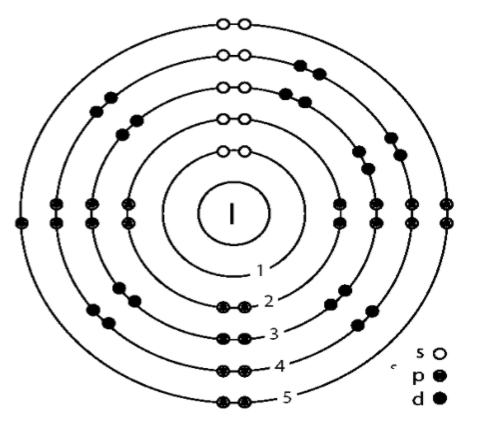
What is the radius of the iodine atom (atomic number is given as
Answer
493.8k+ views
Hint: The radius of this atom can be found by taking the ratio of the product of the radius of the hydrogen atom and the square of the number of shells of the iodine atom to the atomic number of the iodine atom. The electronic configuration of the atom is to be taken in order to find the number of shells. These all may help you to solve this question.
Complete Answer:
The electronic configuration of the iodine atom can be found at first. The atomic number is given as
Therefore the electronic configuration will be written as,
From this we can see that the number of shells can be calculated.
That is,
The radius of an atom can be calculated by an equation given as,
Where
The radius of hydrogen atom is given as,
The atomic number of the iodine atom is given as,
And the number of shells in the iodine atom is already given as,
Substituting the values in it will give,
Simplifying the equation will give the radius of iodine atom,
Therefore the correct answer has been obtained.
The answer is given as option A.

Note:
Iodine is an element in the periodic table which is having the symbol
Complete Answer:
The electronic configuration of the iodine atom can be found at first. The atomic number is given as
Therefore the electronic configuration will be written as,
From this we can see that the number of shells can be calculated.
That is,
The radius of an atom can be calculated by an equation given as,
Where
The radius of hydrogen atom is given as,
The atomic number of the iodine atom is given as,
And the number of shells in the iodine atom is already given as,
Substituting the values in it will give,
Simplifying the equation will give the radius of iodine atom,
Therefore the correct answer has been obtained.
The answer is given as option A.

Note:
Iodine is an element in the periodic table which is having the symbol
Recently Updated Pages
Master Class 10 Science: Engaging Questions & Answers for Success

Master Class 10 Social Science: Engaging Questions & Answers for Success

Master Class 10 Maths: Engaging Questions & Answers for Success

Master Class 10 English: Engaging Questions & Answers for Success

Class 10 Question and Answer - Your Ultimate Solutions Guide

Master Class 9 General Knowledge: Engaging Questions & Answers for Success

Trending doubts
State and prove Bernoullis theorem class 11 physics CBSE

1 ton equals to A 100 kg B 1000 kg C 10 kg D 10000 class 11 physics CBSE

State the laws of reflection of light

One Metric ton is equal to kg A 10000 B 1000 C 100 class 11 physics CBSE

Difference Between Prokaryotic Cells and Eukaryotic Cells

1 Quintal is equal to a 110 kg b 10 kg c 100kg d 1000 class 11 physics CBSE




